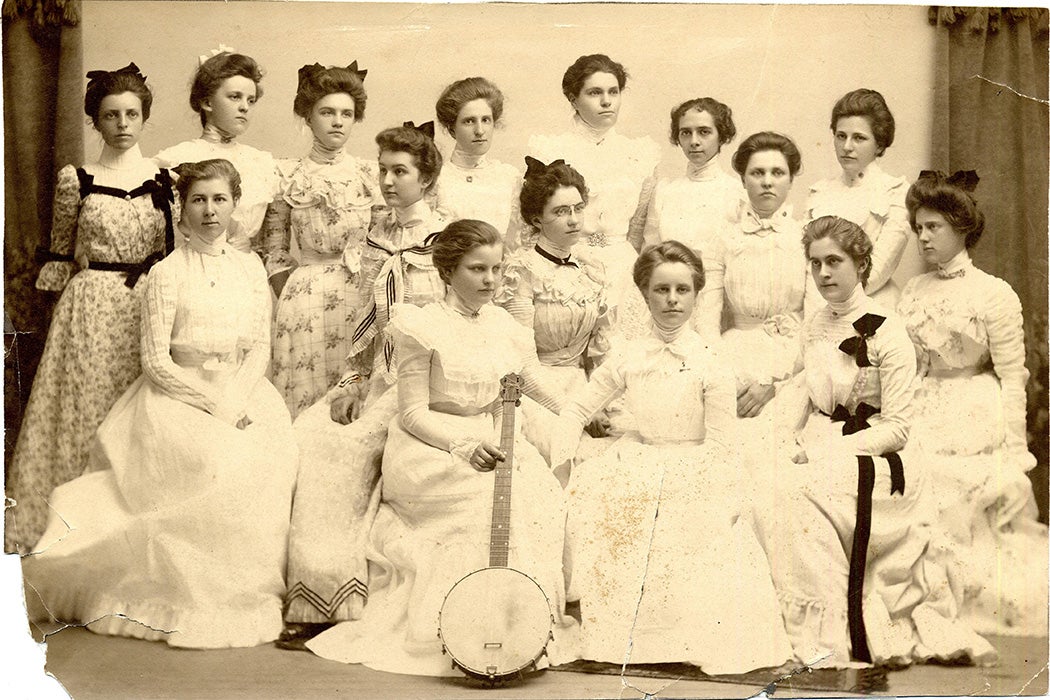The banjo has a complicated status in American entertainment culture. Sure, it may be Kermit the Frog’s favorite instrument, but more often than not, it’s the butt of jokes that make it seem like the gawky nerd of instruments. Literary scholar and editor Wes Davis, a banjo player himself, laments that even in the modern era, with rockers and bluegrass pickers and celebrities in its corner, for most people “the most familiar image of a banjo player…is still the mute, backwoods Georgia boy in John Boorman’s 1972 film Deliverance.” But the banjo has a rich history in North America, its early popularity driven in large part by Black musicians.
Appalachian studies scholar Cecelia Conway documents the instrument’s African origins and notes that “enslaved Africans brought the fretless gourd banjer, its short-drone thumb string, and its downstroke playing style to American settlers.” She traces the banjer’s introduction into North America through Maryland and Virginia in the first half of the eighteenth century, describing a tradition of cultural spread and Black mentorship that eventually led to white immigrants, especially Irish settlers, taking up the instrument. Minstrel entertainment in America, which became widespread in the antebellum years, further popularized the banjo beyond its Black cultural and folk origins.

But this popularity still operated as a niche market. In the nineteenth century, most people associated the instrument with “[B]lack Americans, blackface theaters, and working-class barrooms,” writes ethnomusicologist Karen Elizabeth Linn. In the 1870s, however, players and makers felt it was time to give the banjo a makeover. A re-theming of the instrument and its position in the music world was necessary to appeal to buyers from the middle and upper classes.
This wasn’t a wholesale reinvention, notes Linn, writing about the famous actress “Lotta”—full name Carlotta Crabtree—who played the banjo as part of a wildly popular stage act for more than fifteen years. Lotta wasn’t the most talented performer in New York theater, but she was lively and lauded by The New York Times in 1867 as “a specimen of life, light and beauty.” That the Times also reported that Lotta played “the banjo like a prize negro minstrel” demonstrates her ability to cross boundaries, writes Linn. Theater historian George Odell put it more plainly, she notes, arguing that “Lotta could not act, but she could hold us by sheer power of her magnetic personality. There was always a wonder as to what rule she would break next.”
The popularity of performers like Lotta, combined with increased marketing from banjo makers, caused an enthusiastic uptick in banjo playing by young women in the late nineteenth century. Advertisers strategically renamed the folksy instrument to appeal to female customers. Some spelled the name “banjeaux” to make it seem fancy and French. Others used swishy names for their instrument models, like “Imperial” or “Thoroughbred,” and advertised with tropes of European romantic fiction, including Mediterranean men serenading pretty ladies with their banjo in hand. P. T. Barnum even bought one for his younger second wife, Nancy Fish, perhaps to show he was “with it.”
By the 1880s and 1890s, banjos were all the rage, but it wasn’t the French spelling or the Don Juans that did it. And it wasn’t necessarily the sort of popularity that manufacturers had hoped for, either. When Lydia Hamessley studied nineteenth-century photographs for evidence of women’s adoption of the banjo, she didn’t find upper-class ladies demurely playing in the parlor. Instead, she identified two categories of banjo scenes in stereographs of the era (themselves remarkable for the way they leveraged new imaging technologies to create a sense of three-dimensional space). The “seductive” subset of images showed women in intimate, casual poses with other women, enjoying their musical hobby in relaxed or even risqué clothing, or openly flirting with (or domineering) men. So-called “collegiate” poses, in contrast, involved groups of women with a banjo or two in the mix. These photos might purport to show a group of young friends at a sleepover, sisters chatting, or a daughter home from school with a newfangled musical habit in tow. (Banjo clubs were indeed popular in the 1890s at colleges, though most members were male; Linn describes them as largely social, light organizations with a “jauntily adolescent” vibe.)
The images Hamessley describes are of a piece with the turn-of-the-century New Woman movement, which saw women largely tossing off Victorian “true womanhood” virtues in favor of more expansive schemes of femininity. Along with the banjo, New Women embraced independent movement (bicycles!), education (reading!), and gender flexibility (lounging in one’s underwear, inversion of spousal roles, homosocial behavior). She concludes that “when the rebellious New Woman took up the banjo the stakes were raised: in her hands, the banjo became aligned with inverted gender roles and the neglect of family and children, all of which effeminized men.”
Weekly Newsletter
Even as the banjo became an icon of New Woman feminism (and sold like hotcakes), it couldn’t fully move beyond its sentimental associations in a dominant American culture that saw the instrument’s biggest fans—Black musicians, white women, and white college men—as “emotional, not too rational, and instinctively artistic souls,” argues Linn. In the modern era, the banjo became predominantly associated with Appalachian and country music, receding from mainstream popularity but retaining its identity as “an instrument that’s forever been caught between colliding vectors of American culture.”
Rhiannon Giddens, winner of the 2023 Pulitzer Prize in Music and the 2016 Steve Martin Banjo Prize, and Jake Blount, winner of the 2020 Steve Martin Banjo Prize, are only two of the musicians working to recover and publicize the banjo’s origins, paying tribute not only to the instrument’s fundamental African history but the role of women in making it popular.
Support JSTOR Daily! Join our membership program on Patreon today.







